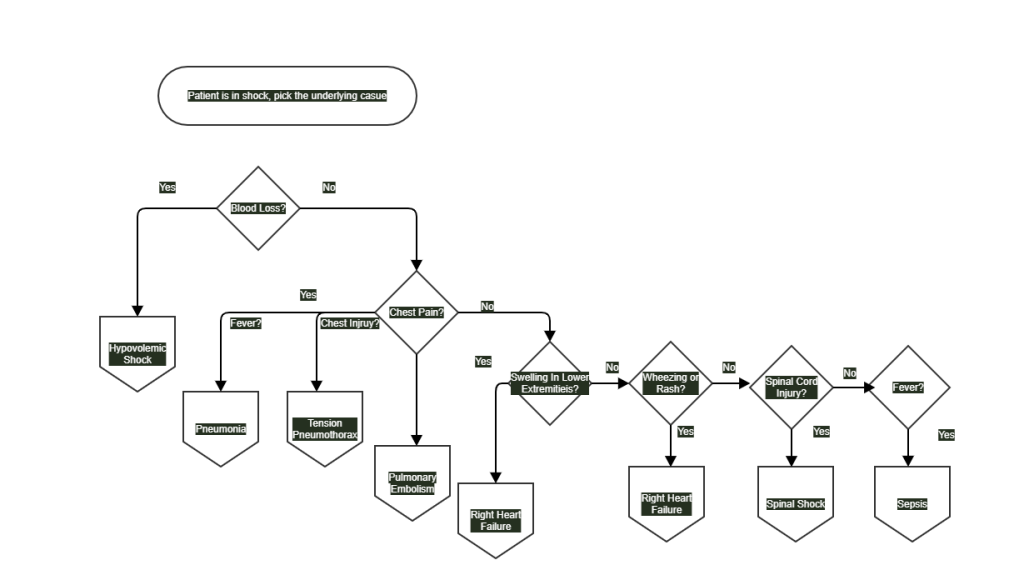How People Die: Obstructive Shock
Published (updated: ).
Less Going In Means Less Going Out

The pipe is under constant pressure, but what happens to the water when a big chunk of ice forms and blocks the pipe? The incoming flow will be obstructed, limited the amount of water the pipes will deliver. The same thing happens when an obstruction occurs in the venous network of the body. As you will recall, the veins bring deoxygenated blood back to the heart to be reoxygenated through the pulmonary capillary beds. What would happen if the blood flow was reduced? The result would be shock. (hypoperfusion). Without the ability to bring the full volume of blood to the heart, less will be pumped out to the body by the left ventricle.
The Bottleneck Restricts Traffic So The Northbound Lane Is Clear

What could cause these obstructions in blood flow?
- Pulmonary Embolism – A blood clot or embolism of some sort (air, amniotic fluid, etc) creates an obstruction in the pulmonary capillary beds resulting in the patient experiencing crippling chest pain, hypotension, and marked respiratory distress.
- Tension Pneumothorax – A build up of air from a pneumothorax that creates a cavity of air inside the thoracic cavity, resulting in tremendous pressure being exerted on the vena cava.
- Heart Failure, specifically the Right Ventricle – The right ventricle fails to pump all the blood it receives to the lungs, which results in a back up of blood to the body (dependent edema)
- Cardiac Tamponade – Blood filling the pericardial sac results in the right ventricle failing to push all the blood out with each contraction. The left ventricle fails to fill up due to the pressure exerted from the blood filled pericardial sac. A similar condition can be found in pericarditis; instead of blood the pericardial sac is filling with infectious pus and swelling.
Now, Enter The JEDI

Other Causes of Shock
Anemia
Anemia is a condition that develops when your blood produces a lower-than-normal amount of healthy red blood cells. If you have anemia, your body does not get enough oxygen-rich blood. The lack of oxygen can make you feel tired or weak. You may also have shortness of breath, dizziness, headaches, or an irregular heartbeat. According to the Centers for Disease Control and Prevention, about 3 million people in the United States have anemia.
There are many types of anemia, including:
- Iron-deficiency anemia
- Vitamin B12-deficiency anemia
- Hemolytic anemia
Mild anemia is a common and treatable condition that can develop in anyone. It may come about suddenly or over time, and may be caused by your diet, medicines you take, or another medical condition. Anemia can also be chronic, meaning it lasts a long time and may never go away completely. Some types of anemia are inherited. The most common type of anemia is iron-deficiency anemia.
Hypovolemia
Hypovolemia refers to a state of low extracellular fluid volume, generally secondary to combined sodium and water loss. All living organisms must maintain an adequate fluid balance to preserve homeostasis. Hypovolemia refers to a state of low extracellular fluid volume, generally secondary to combined sodium and water loss. All living organisms must maintain an adequate fluid balance to preserve homeostasis. Water constitutes the most abundant fluid in the body, at around 50% to 60% of the body weight. Total body water is further divided into the intracellular fluid (ICF), which comprises 55% to 75%, and the extracellular fluid (ECF), which comprises around 25-45%. The ECF is further divided into the intravascular and extravascular (interstitial) spaces. ECF is the more readily measured component as it can be estimated by arterial blood pressure.
Vasodilatory Shock
Vasodilatory shock is a critical manifestation of cardiovascular failure. There is uncontrolled vasodilation and vascular hyporesponsiveness to endogenous vasoconstrictors, causing the failure of physiologic vasoregulatory mechanisms. Unfortunately, only few randomized studies exist to guide clinical management and hemodynamic stabilization in patients who do not respond to the standard approach of managing vasodilatory shock.
Vasodilatory shock occurs anytime blood vessels dilate. Vasodilation can be due to sepsis, anaphylaxis, or an insult to the spinal cord.
